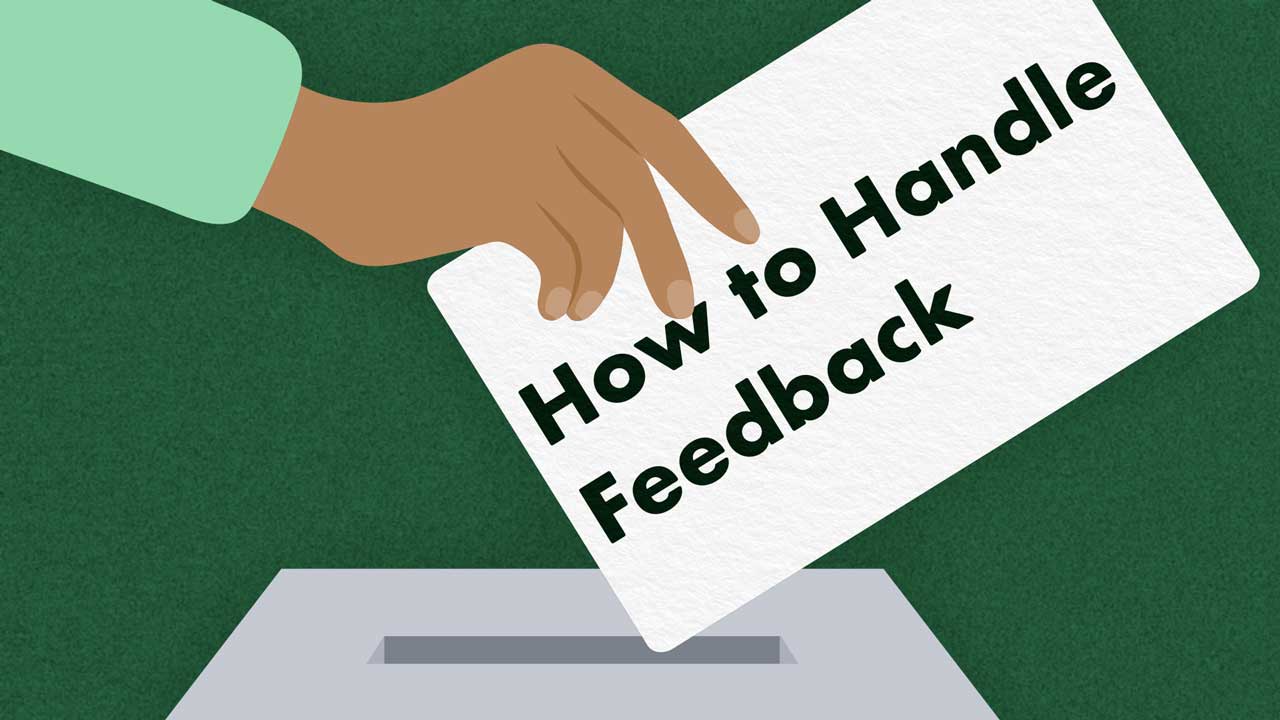The following 10 steps are intended to help you take on and respond to feedback from managers, coworkers and patients in a professional manner.
Your performance at work does not only relate to you. It affects patients, clients, other staff and the overall provision of care. Consider the giving and receiving of feedback as a tool to facilitate improvements to the quality of patient care in your workplace.
1. Manage Your Initial Response (i.e. Avoid Getting Defensive)
When receiving criticism, the best way to manage your response is to take a moment; don’t react straight away. Your initial reaction is likely to be a defence. Taking just one or two seconds will allow your brain to process this new information and moderate your reaction.
Even if you do have a reasonable defence, it may not be as effective if you express it as a snappy quip (Lindsay 2020).
Once you’ve taken some time to think, you might find that you’re ready to respond to what the person has said, or you might want more time.
2. Active Listening
Let the person giving feedback express themselves without interruption. Remember that most people find it daunting to give feedback, so there’s a good chance that they’re raising it for a reason (Lindsay 2020).
If you find it useful, repeat the feedback to the person for clarification, for example, ‘So what you’re saying is that you think I could contribute more to our team meetings?’ Through active listening (listening for the content, intent and feeling), you'll have a better chance of determining the exact intent of the feedback.
3. Consider the Potential Benefits
Rather than interpreting feedback negatively (for example, as a criticism of your character), think of how this feedback might enhance your performance at work. Feedback has the potential to strengthen your skills, productivity, outcomes and relationships.
Even if the feedback is coming from someone who you do not consider to be an expert in their field, it doesn’t mean there’s nothing to glean from what they have to say (Lindsay 2020).

4. Put Yourself in Their Shoes
Imagine you were the one giving feedback. You know that you would only give feedback if you thought it was essential. You might provide feedback because you want to help someone, prevent someone from making a mistake or getting in trouble, or because someone has upset you, a patient or another team member, and they're not aware of it.
Consider the way the person framed their feedback. Upon reflection, you may see ways they tried not to hurt your feelings (Nawalkha 2018).
5. Thank Them Sincerely
Tell the person you appreciate that they’ve taken the time to talk to you about this and thank them for having your development in mind. This can be particularly difficult if you feel put-out by the feedback or if it wasn’t delivered in the most tactful way.
Thanking them doesn’t mean that you agree - it’s just a way of being mature and recognising the effort the person made to give you this feedback (Lindsay 2020).
6. Ask for Examples to Better Understand the Feedback
Ask open-ended questions such as:
- ‘Just to help me understand, what was it about my patient interaction that seemed rushed?’
If they’re having trouble articulating this, ask more direct questions, for example:
- ‘Was it the way I spoke to them? Or, was it the way I took their food tray from their bed?’
This is for your own benefit. Feedback is only useful if you can act on it; it’s hard to act on feedback that is too general.
If they don’t specify, ask whether they perceive this to be an isolated issue or if it’s something they’ve noticed a few times (Lindsay 2020).

7. Request Time to Follow Up
There are a few reasons why you might want to do this. If it’s a large issue, a follow-up will be necessary. If you feel particularly blindsided by the feedback, you might want to talk to other coworkers about it and seek advice (Lindsay 2020).
You might also want time to consider what actions you will take in response to the feedback, beyond what the person giving feedback might have suggested.
Asking for more time also lets the other person know that you’re taking their feedback seriously (Grote 2015).
8. Engage in Self-assessment
This can be hard. You likely do things a certain way because you’ve decided that’s the best way to do it. It can be confronting when someone tells you it isn’t.
One method of self-assessment is to assess your performance in carrying out certain tasks and break them down into distinct components. This way, you will be able to determine where in the process you may have gone wrong (Algiraigri 2014).
9. Be Prepared for it
Know that in any professional work environment, unsolicited feedback could be provided to you at any moment. Be ready for feedback by acknowledging that everyone has room for improvement.
Better still, show maturity and accountability by taking initiative and asking for feedback.
10. Test it / Move On
If after following these steps you’ve come to the realisation that there is room for improvement in your work, act on the feedback. If the suggestions from the person giving feedback don’t sit right with you, brainstorm other ways you could work differently (Way Up 2018).
You might find that your new way of working is actually a powerful tool to help you move forward. Even if that doesn’t happen, you’ll have demonstrated that you’re someone who is able to accept their flaws and work on their performance.
Knowing how to handle feedback is beneficial not only for you but also for the whole organisation and the quality of care being provided.
Recommendations from the National Safety and Quality Health Service Standards
Feedback and complaints management are addressed in Actions 1.13 and 1.14 under Standard 1: Clinical Governance of the National Safety and Quality Health Service Standards.
The following is considered as necessary for an organisation’s development:
The health service organisation:
- Implements processes to facilitate feedback from patients, carers and families about their experience of the organisation and care outcomes
- Implements processes to facilitate feedback from the workforce on their knowledge and understanding of the safety and quality systems.
- Makes use of this information to enhance safety and quality systems.
(ACSQHC 2021)

Further Reading
For more on this topic, read the Ausmed article How to Handle Complaints in Healthcare.
Test Your Knowledge
Question 1 of 3
True or false: It’s easier to act on feedback when it’s general.
Topics
Further your knowledge
References
- Algiraigri, A H 2014, ‘Ten Tips for Receiving Feedback Effectively in Clinical Practice’, Med Educ Online., vol. 19, viewed 17 October 2024, https://www.ncbi.nlm.nih.gov/pmc/articles/PMC4116619/
- Australian Commission on Safety and Quality in Health Care 2021, National Safety and Quality Health Service Standards, 2nd edn, Australian Government, viewed 17 October 2024, https://www.safetyandquality.gov.au/publications-and-resources/resource-library/national-safety-and-quality-health-service-standards-second-edition
- Grote, D 2015, ‘How to Handle Negative Feedback’, Harvard Business Review, 17 August, viewed 17 October 2024, https://hbr.org/2015/08/how-to-handle-negative-feedback
- Lindsay, N 2020, ‘Taking Constructive Criticism Like a Champ’, The Muse, 19 June, viewed 17 October 2024, https://www.themuse.com/advice/taking-constructive-criticism-like-a-champ
- Nawalkha, A 2018, ‘Six Ways To Handle Tough Feedback Like A Pro’, Forbes Coaches Council, 22 October, viewed 17 October 2024, https://www.forbes.com/sites/forbescoachescouncil/2018/10/22/six-ways-to-handle-tough-feedback-like-a-pro/?sh=697632f731e9
- Way Up 2018, How to Handle Feedback at Work, Way Up, viewed 17 October 2024, https://www.wayup.com/guide/handle-feedback-work/
 New
New 

